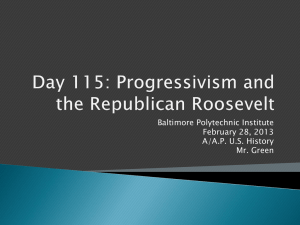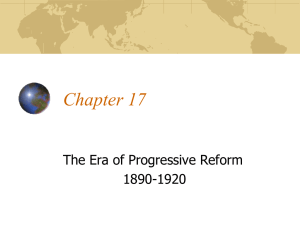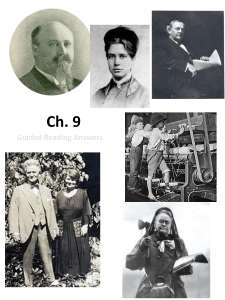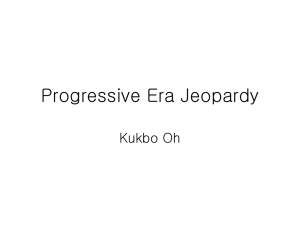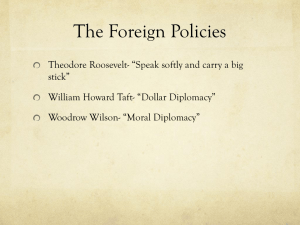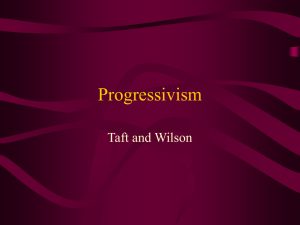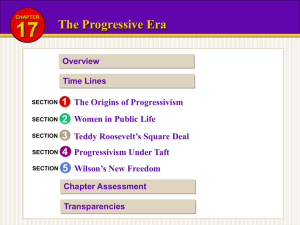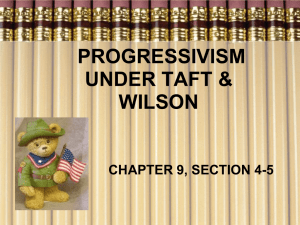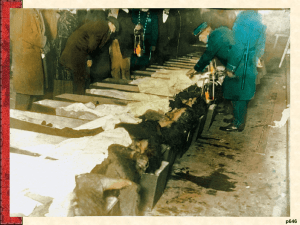Chapter 21 The Progressive Era
advertisement
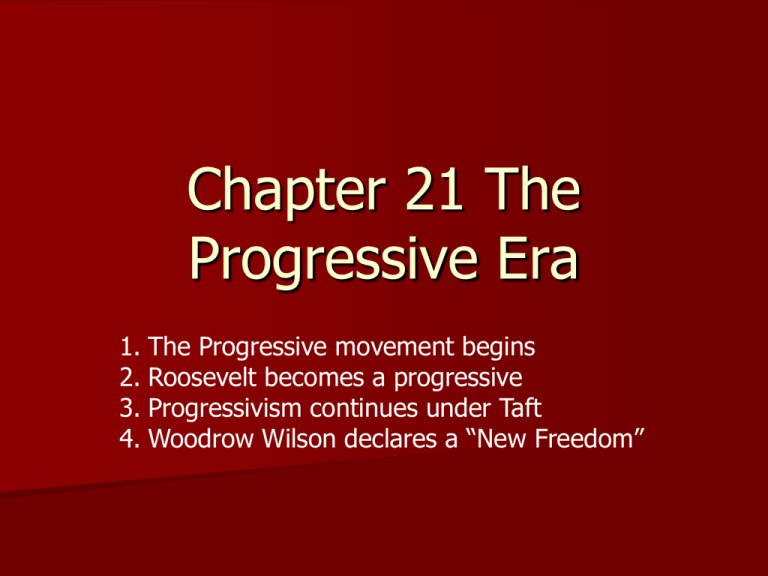
Chapter 21 The Progressive Era 1. The Progressive movement begins 2. Roosevelt becomes a progressive 3. Progressivism continues under Taft 4. Woodrow Wilson declares a “New Freedom” ORIGINS OF PROGRESSIVISM As America entered into the 20th century, middle class reformers addressed many social problems Work conditions, rights for women and children, economic reform, environmental issues and social welfare were a few of these issues Section 1: The Progressive Movement Begins Progressive Movement • 4 Goals 1. 2. 3. 4. • Protecting Social Welfare Creating Economic Reform Promoting Moral Improvement Fostering Efficiency Religious Groups Seek Reform • • YMCA & YWCA Salvation Army 1.PROTECT SOCIAL WELFARE Industrialization in the late 19th century was largely unregulated Employers felt little responsibility toward their workers As a result Settlement homes and churches served the community Also the YMCA and Salvation Army took on service roles MUCKRAKERS EXPOSE SOCIAL EVILS Teddy Roosevelt coined the term, “Muckrakers” and he felt they pointed out only the bad in society. Journalists known as “Muckrakers” exposed corruption in business Some view Michael Moore as a modern muckraker Progressive Movement Continued • Muckrakers • Lincoln Steffens • Ida M. Tarbell • Upton Sinclair exposed Standard Oil Company’s cut-throat methods of eliminating competition Though most Progressives did not embrace socialism, many writers saw the truth in Debs’ criticism • Radical Groups • Socialist Party & Eugene V. Debs 2. CREATE ECONOMIC REFORM The Panic of 1893 prompted some Americans to question the capitalist economic system As a result some workers embraced socialism Eugene Debs organized the American Socialist Party in 1901 Debs encouraged workers to reject American Capitalism 3. PROMOTE MORAL DEVELOPMENT Some reformers felt that the answer to societies problems was personal behavior They proposed such reforms as prohibition Groups wishing to ban alcohol included the Woman’s Christian Temperance Union (WCTU) 4. FOSTERING EFFICIENCY Many Progressive leaders put their faith in scientific principles to make society better In Industry, Frederick Taylor began using time & motion studies to improve factory efficiency Taylorism became an Industry fad as factories sought to complete each task quickly Cleaning up Government Reform Mayors • Hazen Pingree-Detroit--- unemployment built schools & parks lowered street car prices • Thomas L. Johnson-Cleveland hired honest workers, held large city meetings in tents “open transperency” • Samuel M. “Golden Rule” Jones-Toledo believed in applying the teachings of Christ to citizens Reforming Local Governments Galveston, Texas- Commission form of government 5 member commission of EXPERTS Dayton, Ohio- Council-Manager form of government City elects a council who then appoints a manager Under the progressive Republican leadership of Robert La Follette, Wisconsin led the way in regulating big business State Level---Reform Governors Robert M. LaFollette “Fighting Bob”-Wisconsin targeted the Rail Road Industry Protecting Workers • Minimum Wage • Minimum Hours • Child Labor Laws Reforming Elections • Oregon System • Direct Primary—people not party leaders elect candidates of the Party • 17th Amendment—Direct election of Senators by the people, not the members of the House of Representatives. • • • Initiative– Ohio has Referendum--- Ohio has Recall ROOSEVELT AND THE ROUGH RIDERS Roosevelt grabbed national attention by advocating war with Spain in 1898 His volunteer cavalry brigade, the Rough Riders, won public acclaim for its role in the battle at San Juan Hill in Cuba Roosevelt returned a hero and was soon elected governor of NY and later McKinley’s vicepresident Teddy Roosevelt and the Rough Riders Section 2: Roosevelt Becomes a Progressive Leader • • • Assassination of William McKinley T.R. becomes youngest President Square Deal • Increasing Federal Power • Federal Arbitration • • • • • Coal Strike (1902) Trust Busting Regulating Transportation Protecting Health Conserving Natural Resources TRUSTBUSTING By 1900, Trusts – legal bodies created to hold stock in many companies – controlled 80% of U.S. industries Roosevelt filed 44 antitrust suits under the Sherman Antitrust Act 1902 COAL STRIKE In 1902 140,000 coal miners in Pennsylvania went on strike for increased wages, a 9-hour work day, and the right to unionize Mine owners refused to bargain Roosevelt called in both sides and settled the dispute Thereafter, when a strike threatened public welfare, the federal government was expected to step in and help PURE FOOD AND DRUG ACT The Pure Food and Drug Act took medicines with cocaine and other harmful ingredients off the market In response to unregulated claims and unhealthy products, Congress passed the Pure Food and Drug Act in 1906 The Act halted the sale of contaminated foods and medicines and called for truth in labeling ROOSEVELT’S ENVIROMENTAL ACCOMPLISHMENTS Yellowstone National Park, Wyoming Roosevelt set aside 148 million acres of forest reserves He also set aside 1.5 million acres of waterpower sites and he established 50 wildlife sanctuaries and several national parks ROOSEVELT AND CIVIL RIGHTS Roosevelt failed to support Civil Rights for African Americans He did, however, support a few individuals such as Booker T. Washington NAACP FORMED To PROMOTE RIGHTS In 1909 a number of African Americans and prominent white reformers formed the National Association for the Advancement of Colored People The NAACP had 6,000 members by 1914 The goal of the organization was full equality among the races The means to achieve this was the court system • Section 3: Progressivism Continues Under Taft William Howard Taft • Heaviest President • Only person to be both President & Chief Justice of the U.S.S.C. • Tariff Issue • Payne-Aldrich Tariff • Public Lands • Conservation • Gifford Pinchot Progressivism Under Taft • Joe “Uncle Joe” Cannon • Conservatives • Reform-minded Republicans • Bull Moose Party • “New Nationalism” • Roosevelt again • Republican Party splits • Election of 1912 • Taft • Roosevelt • Wilson 1912 ELECTION Republicans split in 1912 between Taft and Teddy Roosevelt (who returned after a long trip to Africa) Convention delegates nominated Taft Some Republicans formed a third party – The Bull Moose Party and nominated Roosevelt The Democrats put forward a reform minded New Jersey Governor, Woodrow Wilson Republicans split in 1912 Wilson Declares a “New Freedom” Progressive Reform Continues Under Wilson • Underwood Tariff • Banking System Reformed • • Liberals • Elastic Currency • Federal Reserve System WILSON’S NEW FREEDOM W. Wilson U.S. President 1912-1920 As America’s newly elected president, Wilson moved to enact his program, the “New Freedom” He planned his attack on what he called the triple wall of privilege: trusts, tariffs, and high finance CLAYTON ANTITRUST ACT In 1914 Congress enacted the Clayton Antitrust Act which strengthened the Sherman Act The Clayton Act prevented companies from acquiring stock from another company (Anti-monopoly) The Act also supported workers unions FEDERAL TRADE COMMISSION FORMED The FTC was formed in 1914 to serve as a “watchdog” agency to end unfair business practices The FTC protects consumers from business fraud Today the FTC has been working on protecting consumers from ID theft FEDERAL INCOME TAX ARRIVES Wilson worked hard to lower tariffs, however that lost revenue had to be made up Ratified in 1916, the 16th Amendment legalized a graduated federal income tax WOMEN WIN SUFFRAGE The 19th Amendment gave women the right to vote in 1920 Native-born, educated, middle-class women grew more and more impatient Through local, state and national organization, vigorous protests and World War I, women finally realized their dream in 1920 th 19 Women’s Suffrage= –women get the right to vote Amendment LIMITS OF PROGRESSIVISM While the Progressive era was responsible for many important reforms, it failed to make gains for African Americans Like Roosevelt and Taft, Wilson retreated on Civil Rights once in office The KKK reached a membership of 4.5 million in the 1920s



